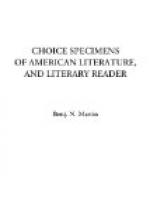Yet we love the artists, in every kind; even these, whose merits we are not quite able to appreciate. Sculptors, painters, crayon sketchers, or whatever branch of aesthetics they adopted, were certainly pleasanter people, as we saw them that evening, than the average whom we meet in ordinary society. They were not wholly confined within the sordid compass of practical life; they had a pursuit which, if followed faithfully out, would lead them to the beautiful, and always had a tendency thitherward, even if they lingered to gather up golden drops by the wayside. Their actual business (though they talked about it very much as other men talk of cotton, politics, flour barrels, and sugar) necessarily illuminated their conversation with something akin to the ideal....
As interesting as any of these relics was a large portfolio of old drawings, some of which, in the opinion of their possessor, bore evidence on their faces of the touch of master-hands.
... According to the judgment of several connoisseurs, Raphael’s own hand had communicated its magnetism to one of these sketches; and if genuine, it was evidently his first conception of a favorite Madonna, now hanging in the private apartment of the Grand Duke, at Florence.... There were at least half a dozen others, to which the owner assigned as high an origin. It was delightful to believe in their authenticity, at all events; for these things make the spectator, more vividly sensible of a great painter’s power, than the final glow and perfected art of the most consummate picture that may have been elaborated from them. There is an effluence of divinity in the first sketch; and there, if any where, you find the pure light of inspiration, which the subsequent toil of the artist serves to bring out in stronger lustre, indeed, but likewise adulterates it with what belongs to an inferior mood. The aroma and fragrance of new thought were perceptible in these designs, after three centuries of wear and tear. The charm lay partly in their very imperfection; for this is suggestive, and sets the imagination at work; whereas, the finished picture, if a good one, leaves the spectator nothing to do, and if bad, confuses, stupefies, disenchants, and disheartens him.
* * * * *
From the “English Note Books.”
=_300._= RUINS OF FURNESS ABBEY.
The most interesting part is that which was formerly the church, and which, though now roofless, is still surrounded by walls, and retains the remnants of the pillars that formerly supported the intermingling curves of the arches. The floor is all overgrown with grass strewn with fragments and capitals of pillars. It was a great and stately edifice, the length of the nave and choir having been nearly three hundred feet, and that of the transept more than half as much. The pillars along the nave were alternately, a round solid one, and a clustered one. Now, what remains of some of them is even with the ground: others




